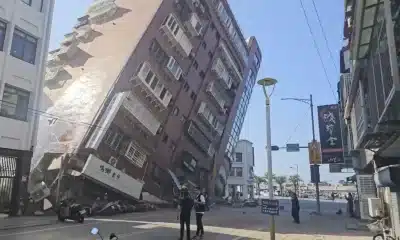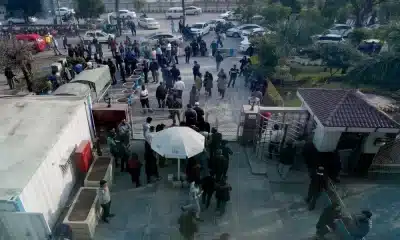World
Powerful Quake Rocks Turkey And Syria, Kills More Than 5,000
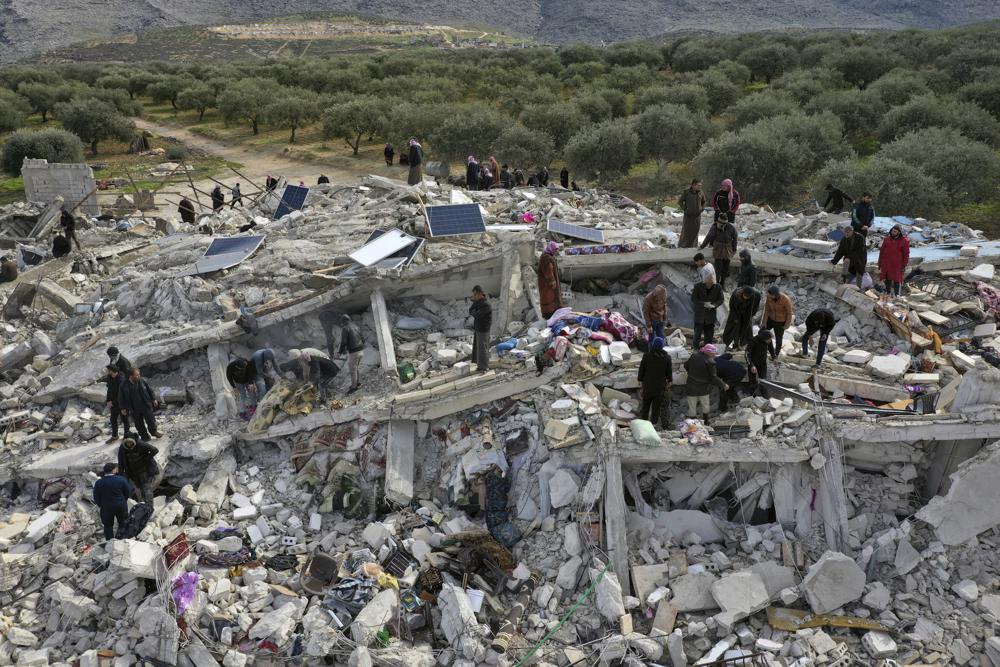
ADANA, Turkey: On Monday, a powerful 7.8 magnitude earthquake shook wide swaths of Turkey and neighboring Syria, killing over 5,000 people and injuring thousands more as it toppled thousands of buildings and trapped residents beneath mounds of rubble.
Authorities were worried that the number of deaths would go up as rescuers searched through twisted metal and concrete for survivors in a region already struggling with Syria’s 12-year civil war and a refugee crisis.
Residents startled awake by the pre-dawn quake rushed outside in the rain and snow to avoid falling debris while those trapped cried out for help. Throughout the day, major aftershocks shook the area, including one nearly as powerful as the initial quake. Workers were still sawing away slabs and pulling bodies after nightfall as desperate families awaited word on trapped loved ones.
“My grandson is one and a half years old. Please, please assist them. We haven’t been able to hear or communicate with them since the morning. Please, they were on the 12th floor,” Imran Bahur sobbed outside her destroyed apartment building in Adana, Turkey. Her daughter and family have yet to be found.
Tens of thousands of people who were left homeless in Turkey and Syria had to spend the night outside in the cold. People in Gaziantep, Turkey, a provincial capital about 33 kilometers (20 miles) from the epicenter, took shelter in shopping malls, stadiums, and community centers. Mosques were opened throughout the region to provide shelter.
The Quake Prompted Seven days Or National Mourning.
Tayyip Erdogan, Turkey’s president, declared seven days of national mourning.
The earthquake, centered in Turkey’s southeastern province of Kahramanmaras, sent residents of Damascus and Beirut fleeing into the streets and was felt as far away as Cairo.
The quake added to the misery in a region that has suffered greatly over the last decade. On the Syrian side, the area is split between government-held land and the country’s last opposition stronghold, which is surrounded by government forces with help from Russia. Meanwhile, Turkey is home to millions of civil war refugees.
According to the White Helmets, an opposition emergency organization, hundreds of families remained trapped in rubble in the rebel-held enclave. The area is densely populated, with approximately 4 million people displaced from other parts of the country due to the war. Many of them live in buildings that previous bombardments have already destroyed.
According to rescue workers, strained health facilities quickly filled with injured. According to the SAMS medical organization, others, including a maternity hospital, had to be emptied.
According to Orhan Tatar, a disaster management official in Turkey, over 6,400 people were rescued across ten provinces.
Earth Quakes Frequently shake Up the Area.
The area is situated on major fault lines and is frequently shaken by earthquakes. In 1999, similar powerful earthquakes struck northwest Turkey, killing 18,000 people.
The US Geological Survey assigned a magnitude of 7.8 to Monday’s quake, which occurred at a depth of 18 kilometers (11 miles). A 7.5 magnitude earthquake struck more than 100 kilometers (60 miles) away hours later.
The second jolt in the afternoon caused a multistory apartment building in the Turkish city of Sanliurfa to topple face-forward onto the street. According to a video of the scene, the structure disintegrated into rubble and created a cloud of dust as bystanders screamed.
There were reports that thousands of buildings had fallen down in a large area that went from Aleppo and Hama in Syria to Diyarbakir in Turkey quake, which is more than 330 kilometers (200 miles) to the northeast.
Authorities reported that over 5,600 buildings were destroyed in Turkey alone. Hospitals in the Turkish city of Iskenderun were damaged, and one collapsed.
Dr. Steven Godby, an expert on natural disasters at Nottingham Trent University, thinks that the rescuers may have less time to save trapped people if it is very cold. He said that working in war-torn civil areas would complicate rescue efforts even more.
Countries Around The World Are Offering Their Assistance
Hundreds of countries, the European Union, and NATO all offered help, like search-and-rescue teams, money, and medical supplies. Most of them were going to Turkey. Russia and even Israel had promised to help the Syrian government, but it was not clear if any would make it to the rebel-held pocket in the northwest, which was in ruins.
Syrian Civil Defense, which is part of the opposition, has said that the situation in the enclave is “disastrous.”
The government and Russia have been bombing the area held by the opposition in Idlib province for years. Everything the territory needs, from food to medicine, comes from neighboring Turkey.
Osama Abdel Hamid told a hospital in Idlib that most of his neighbors died. He claimed their four-story shared building collapsed as he, his wife, and three children ran for the exit. A wooden door fell on them, serving as a shield.
“God gave me a fresh start,” he said.
The bodies of several dead children, wrapped in blankets, were brought to a hospital in the small Syrian rebel-held town of Azmarin in the mountains near the Turkish border.
Four or five TV screens in Turkey showed live coverage of rescue efforts in the provinces that were hit the hardest.
Rescuers pulled two children alive from the rubble in Kahramanmaras, and one could be seen lying on a stretcher on the snowy ground. CNN Turk says that a rescue dog found a woman who was still alive and brought her to safety in Gaziantep.
Over 12.000 Injured In Ten Different Turkish Provinces
In Adana, about 20 people, some wearing emergency rescue jackets, used power saws to saw out space for survivors to climb out or be rescued from a collapsed building’s cement mountain.
“I don’t have the strength anymore,” one survivor could be heard saying from beneath the rubble of another building in Adana earlier in the day as rescue workers tried to reach him, according to a resident, Muhammet Fatih Yavuz, a journalism student.
Hundreds of rescue workers and civilians formed lines across a mountain of wreckage in Diyarbakir. They passed down pieces of broken concrete, household items, and other debris as they looked for people who were trapped under the wreckage.
According to Turkish authorities, at least 1,762 people were killed, and over 12,000 were injured in ten Turkish provinces. According to the Health Ministry, the death toll in government-held areas of Syria has risen to 593, with 1,400 injured. At least 450 people have died and hundreds have been hurt, according to groups that work in the rebel-held northwest of the country.
Huseyin Yayman, a legislator from Turkey’s Hatay province, said several family members were trapped beneath the rubble of their collapsed homes.
“There are so many other people trapped,” he told Haber Turk television over the phone. “So many buildings have been damaged. There are people on the streets. It’s winter; it’s raining.”
SOURCE – (AP)
World
Do Microplastics in the Atmosphere Endanger Your Fertility?
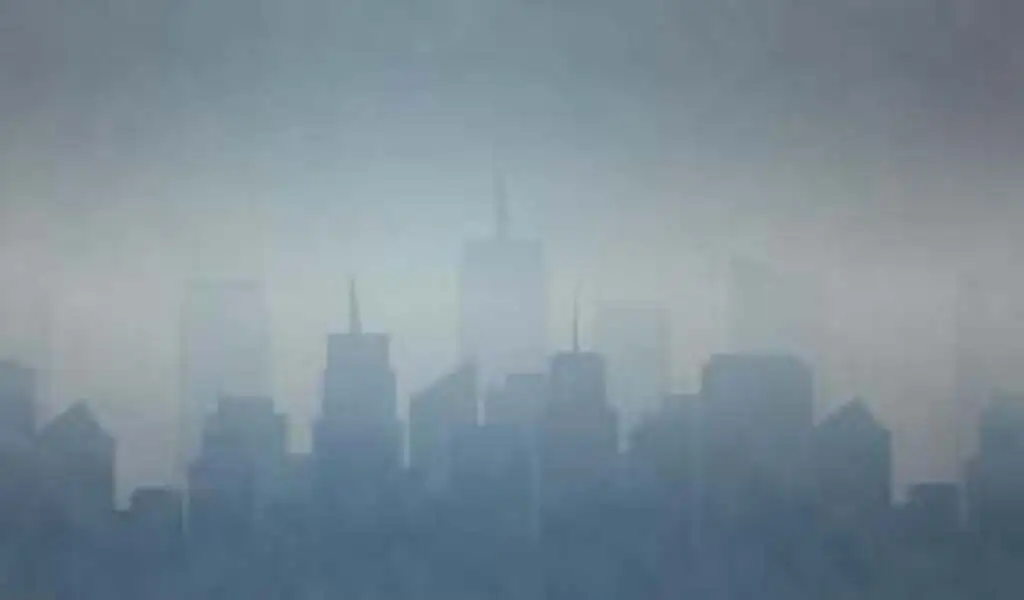
(VOR News) – It is quite possible that the presence of small microplastic particles in the air may be a contributing factor to a wide variety of health problems, including malignancies of the lungs and colon.
This is something that needs additional research to be determined. There is one more item to take into consideration, and that is the potential that this is the exact circumstance.
A recent study found that tires and debris that are decomposing shed minute fragments of plastic that go airborne, so creating a form of air pollution that is not particularly widely known. This type of pollution is caused by the degradation of plastic. An example of this type of pollution is that which is discharged into the atmosphere.
The industry refers to microplastic as “air pollution.”
According to the findings of a researcher named Tracey Woodruff, who is a professor of obstetrics, gynaecology, and reproductive sciences at the University of California, San Francisco, “These microplastics are basically particulate matter from air pollution,” and it is common knowledge that this particular type of air pollution is particularly hazardous.
The researchers who supplied background notes stated that the size of microplastics is less than 5 millimetres, which is smaller than a grain of rice.
This information was provided, according to researchers. These details were supplied by the researchers who conducted the study. These particulars were provided by researchers who were responsible for carrying out the study.
The amount of plastic that is created on a yearly basis by enterprises all over the world is roughly 460 million tonnes, as indicated by the data that were provided by academics all over the world. The forecasts indicate that by the year 2050, this quantity is anticipated to have increased to 1.1 billion tonnes.
Driving is a substantial contributor to the amount of plastic that is floating around in the atmosphere, according to the conclusions of the experts who conducted the study about the phenomenon. When tires are worn down to the point where they scrape against the surface of the road, they allow microplastics to be released into the environment.
As a result of the tires wearing down, this occurs. This impact is brought about as a consequence of the inevitable amount of wear and tear that tires are subjected to.
A study that was published on December 18 in the journal Environmental Science & Technology was the result of researchers conducting an examination of data collected from over 3,000 previous investigations.
The paper was published as a consequence of this procedure. The review was constructed with the help of this analysis that was carried out.
Microplastic used this analysis to put together the review.
A number of diseases, such as cancer, lung problems, and infertility, may be influenced by the presence of microplastics in the air, according to the data, which led to the conclusion that this may be the case.
Despite the fact that the vast majority of the studies that were incorporated into the study were carried out on animals, the researchers claimed that it is very certainly plausible that the findings can also be applied to people. The fact that the majority of investigations were conducted on animals does not change the reality that this is the case.
“We urge regulatory agencies and policy leaders to consider the growing evidence of health harms from microplastics, including colon and lung cancer,” stated Nicholas Chartres, the principal investigator and senior research fellow at the University of Sydney.
The organisation reported this comment. The University of California, San Francisco (UCSF) issued a press release on behalf of the organisation that contained this statement. The news release was disseminated to the public. We are convinced that state officials will act quickly to make sure that no leaks of this kind occur, which is of the highest importance.
SOURCE: USN
SEE ALSO:
Justin Trudeau’s Fight for Gender Equity in Canada
Liberal MPs Call on Trudeau to Resign
World
Russian Oil Ships In The Kerch Strait Are Undergoing Rescue Operations.
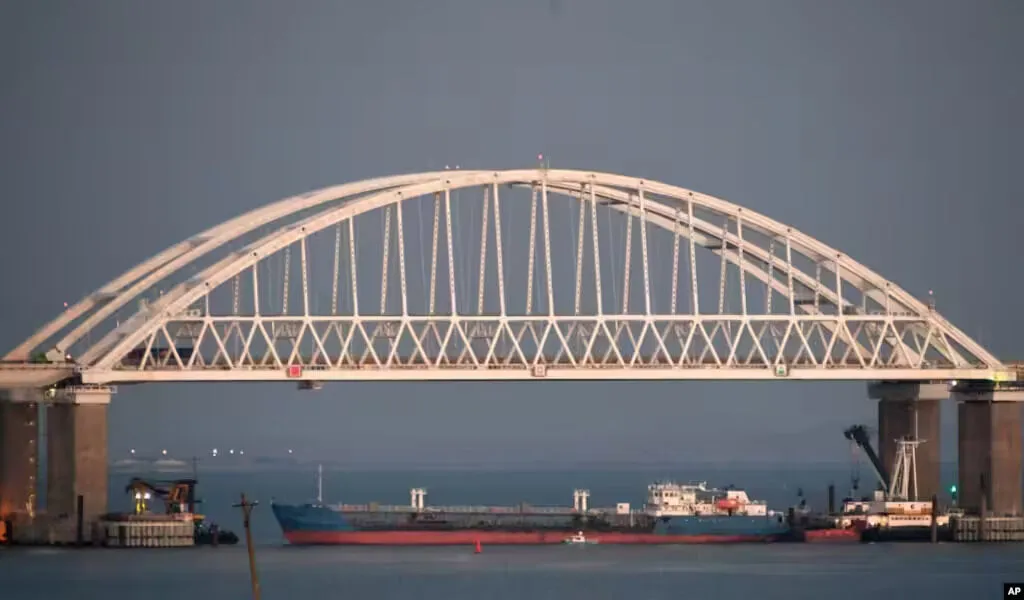
(VOR News) – Following Sunday’s powerful storm, a Russian oil tanker carrying hundreds of tonnes of oil products ultimately broke apart, causing an oil spill into the Kerch Strait below. Additionally, Russian officials reported that the damage was causing problems for another vessel.
Sunday, Russian authorities announced an emergency rescue operation.
According to the Russian state news agency TASS, which claimed the Emergency Situations Ministry as its source, the Volgoneft-212 tanker, carrying fuel oil and carrying thirteen crew members, ran aground and suffered damage to its bow. A shipment of fuel oil was being transported by the tanker.
Authorities have told the public that the damage was brought on by the extreme weather conditions that are currently occurring.
A second tanker, the Volgoneft-239, was damaged during the storm and is currently stranded in the same area with 14 crew members on board, according to the Ministry of Emergency Situations. The tanker was discovered abandoned and alone in the same spot.
Additional tankers also suffered damage. The 132-meter-long cruiser, which was constructed in 1973, hangs the Russian flag around its neck.
The footage posted by state media showed the 136-meter Volgoneft-212 tanker, which was cut in two with its bow underwater, and waves crashing over its deck. At least one person lost his life as a result of this tragedy. This led to the opening of two distinct criminal investigations by the Russian authorities to look into potential violations of certain safety regulations.
Having flown the Russian flag since 1969, the yacht was finished.
Rosmorrechflot, the Russian government agency in charge of water transportation, reported a petroleum product spill.
It is believed that the cargo capacity of each tanker is around 4,200 tonnes of oil products.
The magnitude of the leak and the cause of the substantial damage one of the tankers received were not specified in the official remarks. This is in accordance with the official remarks.
Several news sites cited Kremlin spokesperson Dmitry Peskov as saying that President Vladimir Putin directed the formation of a working committee to handle the rescue effort and lessen the effects of the oil disaster.
Peskov recommended that the government appoint the working committee’s members. This comment was made public right after Putin met with the ministries responsible for ecology and disaster management.
The Russian government has said that it will be sending more than fifty individuals and pieces of equipment to the area in response to the current crisis. Mi-8 helicopters and rescue tugboats are examples of these people and tools.
The news that experts are presently investigating the damage at the event site was announced by Svetlana Radionova, who is in charge of Rosprirodnadzor, Russia’s natural resources regulating entity.
Kommersant reports that Volgoneft-212 used 4,300 tonnes of fuel oil.
The footage, which showed a partially submerged ship and murky water on rough seas, was posted to Telegram without the owner’s consent.
The warships were located in the Kerch Strait, which separates Crimea from the Russian mainland, when the distress signals were sent out.
The Kerch Strait is a crucial international marine passage that connects the Black Sea with the Sea of Azov, allowing for easier traffic between the two bodies of water. It also acts as a border between Russia and the Crimean Peninsula, which is under Russian occupation. The Kerch Strait is located in the centre of the two nations.
The peninsula has remained a major source of contention between the two national governments ever since Russia annexed it from Ukraine in 2014. Russia was the one who seized the peninsula. Ukraine brought legal action against Russia before the Permanent Court of Arbitration in 2016.
Specifically, the lawsuit claimed that Russia intended to illegally take over a location. The argument was supported by evidence pertaining to Russia’s conduct in the region. In 2021, the Russian Federation closed the strait for several consecutive months
SOURCE: VN
SEE ALSO:
Indian Students Studying in Canada Fret Over Visa Scrutiny
Trudeau Sparks Anger After Labeling Trump Voters “Misogynists”
World
Japan List Cannabis as Narcotic Criminalizes Recreational Use
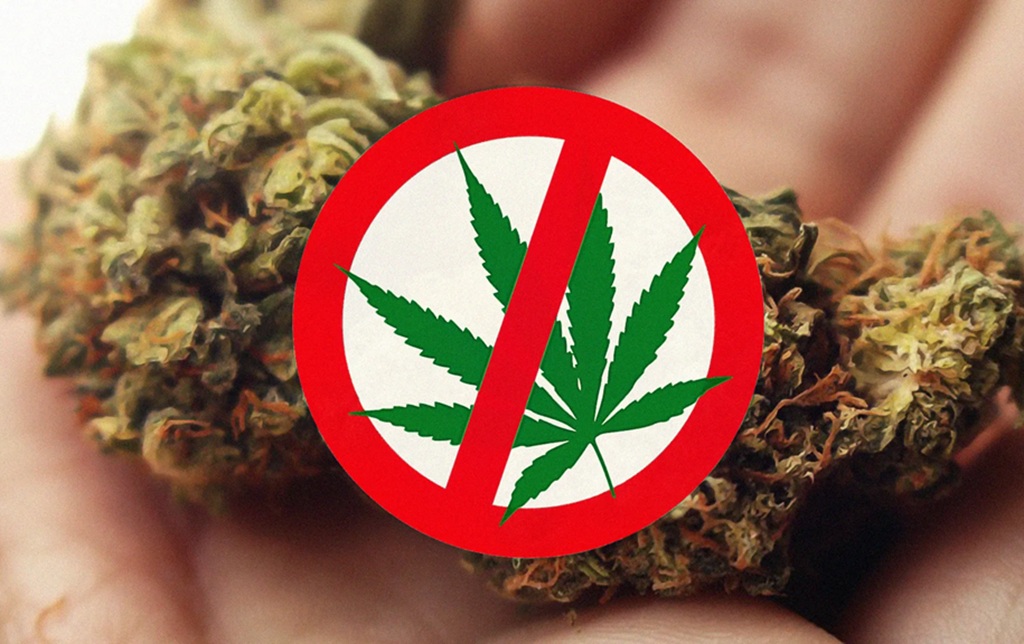
TOKYO – Japan updated its cannabis and narcotics control legislation on Thursday, criminalizing cannabis (Marijuana) use and tetrahydrocannabinol (THC), imposing a maximum seven-year prison sentence.
While the possession, transmission, and cultivation of cannabis and THC were already prohibited in Japan, the new rules will classify them as narcotics and criminalize their use as well, with a prison sentence of up to seven years for violations.
The amended regulations also legalize medical items containing cannabis-derived compounds that are beneficial and safe.
In 2019, 1.8 percent of the Japanese population had used cannabis at least once, making it the country’s second most popular illicit substance behind methamphetamine.
In 2023, a record 6,703 people were probed in cannabis-related criminal cases in Japan, topping methamphetamine cases for the first time, according to the Health, Labour, and Welfare Ministry. Seventy percent of instances involved people under the age of thirty.
A nationwide poll performed the same year by the ministry’s research group estimated that approximately 200,000 people had consumed marijuana within the previous year.
Japan previously did not penalize cannabis usage, apparently taking into account farmers who may have accidentally ingested the drug while producing cannabis plants for use in hemp products.
The amendments will also lift a restriction on cannabis-derived medicines, putting them under a licensing system similar to other drugs used for pain relief and other purposes.
Drugs derived from cannabis plants were only allowed in clinical studies in Japan, but patient groups have been advocating for access to cannabis-derived cannabidiol treatments already licensed in Europe and the United States for illnesses like severe epilepsy.
Cannabis cultivation dates back to the Jōmon period of Japanese prehistory, roughly six to ten thousand years ago (source: Wikipedia).
Cannabis hemp, as one of Japan’s first cultivated plants, provided an essential supply of plant fibre for clothing, cordage, and Shinto ritual goods, among other uses.
For much of Japanese history, hemp was common for fabric and food before cotton emerged as the country’s dominant fibre crop during industrialization during the Meiji period.
Following the end of World War II and the occupation of Japan, the Cannabis Control Law prohibited cannabis possession and manufacturing.
Related News:
Japan’s Mount Fuji Implements Tourist Tax In Response To Overcrowding Concerns
Germans Celebrate As Recreational Cannabis Use Becomes Legal
-
Politics4 weeks ago
Miller Expects 4.9 Million Foreigners to Leave Canada Voluntarily
-
News3 weeks ago
Nolinor Boeing 737 Crash Lands in Montreal
-
News3 weeks ago
“Shocking Video” Vancouver Police Shoot Armed Suspect 10 Times
-
Tech4 weeks ago
Increasing its Stake in OpenAI by $1.5 Billion is a Possibility for SoftBank.
-
News4 weeks ago
Facebook Securities Fraud Case Dropped
-
Health4 weeks ago
A Canadian Teenager’s Bird Flu Virus Has Mutations







